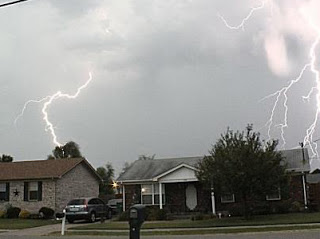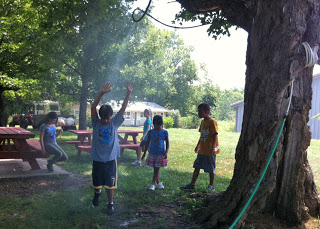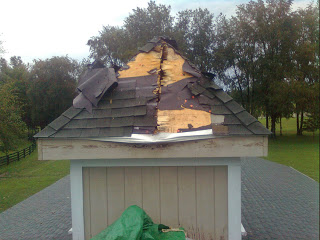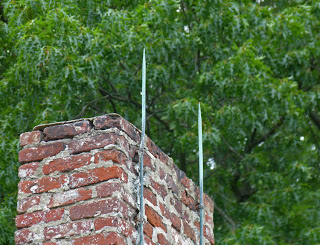The drought and heat in Kentucky have not been pleasant this summer. For Nature Camp, we turned on the sprinklers in the maple tree, so everyone could cool off, as well as having lots of fun!
As the last campers headed for home on the last day of camp, the dark clouds started rolling in. The rumbling thunder got louder and louder, until…
…CRAACCKKK! BOOOMMMMMM! Lightning struck the cupola on top of the maintenance building (the tallest spot in an open field), and travelled down the electrical wiring into the building, frying all the electrical circuits and outlets.
The old saying about lightning not striking twice in the same place is completely untrue, so I thought this would be a good opportunity to talk about safety in thunder storms.
Lightning is a giant discharge of electricity accompanied by a brilliant flash of light and a loud crack of thunder. The spark can reach over five miles (eight kilometers) in length, raise the temperature of the air by as much as 50,000 degrees Fahrenheit (27,700 degrees Celsius), and contain a hundred million electrical volts. Lightning detection systems in the United States monitor an average of 25 million strokes of lightning from clouds to ground during some 100,000 thunderstorms every year. It is estimated that Earth as a whole is struck by an average of more than a hundred lightning bolts every second. You can track and learn more about lightning at http://www.intellicast.com/Storm/Severe/Lightning.aspx
During a thunderstorm, each flash of cloud-to-ground lightning is a potential killer. The determining factor on whether a particular flash could be deadly depends on whether a person is in the path of the lightning discharge. In addition to the visible flash that travels through the air, the current associated with the lightning discharge travels along the ground. Although some victims are struck directly by the main lightning stroke, many victims are struck as the current moves in and along the ground. If you can hear thunder, you are within 10 miles (16 kilometers) of a storm—and can be struck by lightning. Seek shelter and avoid situations in which you may be vulnerable.
Use the 30-30 rule when visibility is good and there is nothing obstructing your view of the thunderstorm. When you see lightning, count the time until you hear thunder. If that time is 30 seconds or less, the thunderstorm is within six miles (ten kilometers) of you and is dangerous. Seek shelter immediately.
A house or other substantial building offers the best protection from lightning. For a shelter to provide protection from lightning, it must contain a mechanism for conducting the electrical current from the point of contact to the ground. These mechanisms may be on the outside of the structure, may be contained within the walls of the structure, or may be a combination of the two.
On the outside, lightning can travel along the outer shell of the building or may follow metal gutters and downspouts to the ground. Inside a structure, lightning can follow conductors such as the electrical wiring, plumbing, and telephone lines to the ground.
 |
| Photo by Don Spain |
Most lightning deaths and injuries in the United States occur during the summer months, when the combination of lightning and outdoor activities reaches a peak. People involved in activities such as boating, swimming, fishing, bicycling, golfing, jogging, walking, hiking, camping, or working outdoors all need to take the appropriate actions in a timely manner when thunderstorms approach. Where organized sports activities take place, coaches, umpires, referees, or camp counselors must protect the safety of the participants by stopping the activities sooner, so that the participants and spectators can get to a safe place before the lightning threat becomes significant.
Inside homes, people must also avoid activities which put their lives at risk from a possible lightning strike. As with the outdoor activities, these activities should be avoided before, during, and after storms. In particular, people should stay away from windows and doors and avoid contact with anything that conducts electricity, including landline telephones. Most people hurt by lightning while inside their homes are talking on the telephone at the time.
Please, when you hear rumbling thunder, even at a distance, take the threat seriously. Remember, “when thunder roars, go indoors!”





